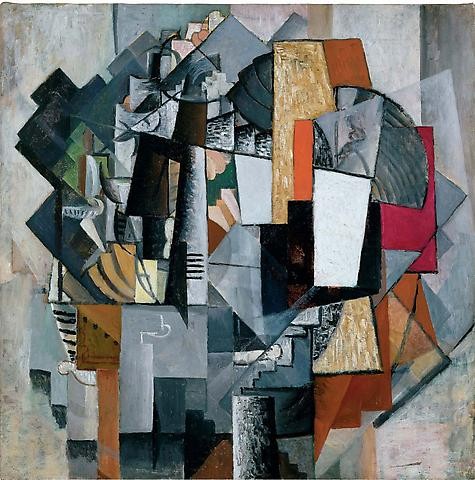Malevich and The American Legacy
03 Mar - 30 Apr 2011
3 March - 30 April,, 2011
I have transformed myself into the zero of form and dragged myself out of the rubbish-filled pool of Academic Art. I have destroyed the ring of the horizon and escaped from the circle of things, from the horizon-ring which confines the artist and the forms of nature.
--Kazimir Malevich
It’s obvious now that the forms and colors in the paintings that Malevich began painting in 1915 are the first instances of form and color.
---Donald Judd
Gagosian Gallery is pleased to present the exhibition “Malevich and the American Legacy” at 980 Madison Avenue, New York.
The exhibition has been conceived in close collaboration with the heirs of Kazimir Malevich and features six rare and pivotal paintings, including Painterly Realism of a Football Player--Color Masses in the 4th Dimension (1915) that was recently acquired from the heirs of Malevich by the Art Institute of Chicago. They are brought together with works by modern and contemporary American artists including Carl Andre, John Baldessari, Alexander Calder, Dan Flavin, Donald Judd, Ellsworth Kelly, Agnes Martin, Barnett Newman, Ad Reinhardt, Ed Ruscha, Robert Ryman, Richard Serra, Frank Stella, James Turrell, and Cy Twombly. Major museums including The Museum of Modern Art, New York, the Nasher Sculpture Center, and Storm King Art Center have lent works; others have been borrowed from the personal collections of Twombly, Kelly, and Ruscha.
In the ferment of the early twentieth century Russian art scene, Malevich, one of the pioneers of non-objective art, developed Suprematism as an art of pure form. He envisioned his Suprematist paintings as geometry stripped of any attachment to the mimetic representation of real objects; the elemental alphabet of a pictorial language outside the visual world. Suprematism thus conveyed what Malevich believed was the supreme reality of existence: pure feeling. His works were first shown in the West in 1927, when he traveled to Germany with over seventy works of art, which were included in the “Große Berliner Kunstausstellung” (Great Berlin Art Exhibition). Subsequently, Alfred H. Barr, Jr. included several paintings in the groundbreaking exhibition “Cubism and Abstract Art” at The Museum of Modern Art in New York in 1936. In 1939, the Museum of Non-Objective Painting opened in New York, whose founder, Solomon R. Guggenheim – an early and passionate collector of the Russian avant-garde – was inspired by the same aesthetic ideals and spiritual quest that exemplified Malevich’s art.
These pivotal events in American cultural history, together with subsequent publications and exhibitions progressively increased Malevich’s exposure in the United States. The first U.S. retrospective of Malevich’s work in 1973 at the Solomon R. Guggenheim Museum provoked a flood of interest and further intensified his impact on postwar American artists. Since that time there have been few opportunities to see Malevich’s works in the United States outside of museums and to examine the ongoing effects of his enduring influence. By providing an opportunity for both, “Malevich and the American Legacy” seeks to contribute to the expanding scholarship on the influence of the Russian visionary.
It is not only formal analogy that connects Malevich and American artists but also deeper aesthetic, conceptual, and spiritual correspondences. In dialogue with his work and ideas, they searched for elemental and universal forms consistent with simplified aesthetic aims. Barnett Newman’s By Twos (1949), Ellsworth Kelly’s White Square and Black Square of 1953, a black 1955 Abstract Painting by Ad Reinhardt, and No. 3 (Plum and Black) by Mark Rothko all respond to Malevich’s ultimate proposition in Black Square (1915) while David Smith’s Cubi (1964), Richard Serra’s Malmo Roll (1964) and Donald Judd’s untitled stack (1982) expound in three dimensions on his more complex, planar Suprematist compositions. Subtly modulated paintings by Brice Marden and Robert Ryman build compositions from the most elemental of forms into unique and multifaceted embodiments of material and process. Ironic ripostes are provided by John Baldessari’s Violent Space Series: Two Stares Making a Point but Blocked by a Plane (for Malevich) (1976) in which a white square reminiscent of Malevich’s White On White is used to mask the crucial part of a noirish movie-still, creating a lacuna that shifts the emphasis from the act itself to the responses surrounding it; and by Ed Ruscha’s bleach paintings, which transform verbal threats into cesura. From the current generation of artists in their ascendancy, Charles Ray, Mark Grotjahn, and Banks Violette’s charged abstractions testify to Suprematism’s dramatic reach into the present and allow for its future impact.
The exhibition will be accompanied by a fully illustrated and scholarly catalogue with essays by Yve-Alain Bois, Magdalena Dabrowski, and Aleksandra Shatskikh.

